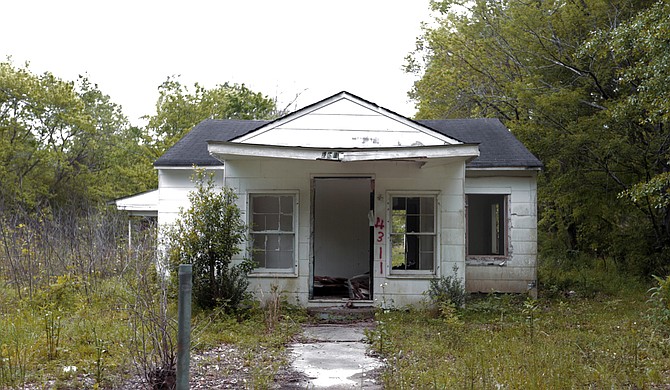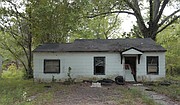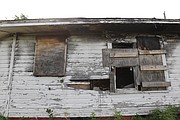This house on Wainwright Street, like more than 3,000 other properties across Jackson, is owned by the State of Mississippi. It was forfeited in 2012 after owners accumulated four years of unpaid property taxes. Photo by Imani Khayyam.
JACKSON — Anna Wilson sat on her porch in the fading afternoon sun, lording over the 10-foot-tall piles of debris in the lot across from her house.Her lawn, immaculately cut, heavily decorated and bordered by a chain-link fence, contrasts heavily with the overgrown and wild space of the other houses on the street. She pointed across the street to deep track marks, freshly pressed into the dirt where a burned husk of a house had barely stood until Friday, May 13. The demolition finally came after eight years of her dedication and persistence.
She was not shy about what she did to bring it down. "I've been calling about it since 2008," Wilson said, shaking her head and pointing her finger across the street, "and they finally tore it down last Friday."
Wilson lives deep in south Jackson on Beaufort Street. The demolition of the house, carried out by the Jackson Police Department's Community Improvement division, was quick and easy. That was mostly due to the fact, she said, that the house had been a charred eyesore for years, almost a decade.
"All they had to do was push it," Wilson said, "because it was burned up."
State-Owned Crime Magnets
Wilson's bete noire is a common situation all over Jackson—dilapidated houses blighting neighborhoods number in the triple-digits at least—but in some places the blight is more concentrated. Lots across the Washington Addition, for example, sit abandoned as overgrown plots with crumbling houses, some of them burned ruins just south of Jackson State University.
Since September 2014, JPD's Community Improvement division, led by Commander Jaye Coleman, has been charged with destroying these dangerous eyesores. The police leading the demolition effort is the only thing that seems to work in a resources-strapped city.
"(There) had not been one house torn down in I don't know how long," JPD Chief Lee Vance said in an interview in his office last summer. "A lot of these houses belong to, guess who, the State of Mississippi, and they ain't paying a dime to do it."
The State of Mississippi, in fact, owns 3,000 lots that dot the capital city, and especially in some of the poorer neighborhoods, like the Washington Addition, wherein the state owns over a hundred lots. Many, including Jackson State University's 22 lots just to the east of the campus itself, are in the possession of the state-level entities.
"The situation we have with that is approximately 85 percent of the properties are state-owned property," Coleman said during a May 10 phone interview.
Even with state ownership, the City of Jackson usually has to foot the bill for cleaning the lots or demolishing the houses, or they continue to sit, rot and attract children to play amid the rotted wood, garbage and broken glass, or even become drug dens.
Mayor Tony Yarber said the departmental transfer of responsibility to JPD was to give strength to the code enforcement in the city. "The division needed enforcement authority," Yarber said in a statement. "There was no enforcement under the Department of Planning. The Jackson Police Department empowered the division to enforce key quality-of-life ordinances. It continues to prove itself with achievements in demolition, grass and weeds, and board-up rates."
Yarber created the division out of thin air, allotting the code-enforcement officers with a total budget of $1.4 million to address the city's problems with blight. Out of that fiscal-year 2015 budget, $525,634 was for salaries, with a total of $661,148 for personal services, which includes insurance and pension contributions. The division was budgeted $165,000 for contracts for "grass, weeds, board up" and $287,000 for "contract construction." The line item for "contract demolition structures" was only $2,500. Jackson recently released its audit of the city's finances but has yet to release the budget for fiscal-year 2016.
Recently, the division celebrated its 200th demolition. The officer in charge says that to citizens all that matters is the blight be addressed rather than whether or not the City owns the property. "That's what most people are worried about," Coleman said.
'Blight Fosters Crime'
Chief Vance drove his black SUV slowly along the swampy-feeling Wainwright Street in "the Bottom" on April 15, where lush, green trees closed in, leaving it feeling more like a tropical movie set and less like the middle of a capital city in the United States.
The chief pointed to a row of crumbling houses his department would soon take down, still barely standing and overgrown with weeds, with broken windows and open doors inviting young explorers or criminals who stay in the Second Precinct.
"We're closing in on 200 houses," Vance said, then paused. "Look at this, Donna: Three little kids walking right down the street. What burns my biscuit—that one's got markings, too—is that people shouldn't just leave property like this."
As Vance talked at the corner of Wainwright and Eisenhower, three young, black boys, probably 7 or 8 years old, were sauntering along the street as little boys do, one of them pushing a bicycle, as the chief's black SUV slowly approached. As the children turned their heads and saw the vehicle, they must have smelled a cop, suddenly running away past a string of abandoned houses.
"A lot of these properties, too, belong to the State," the chief said, shaking his head.
"We shouldn't have to be doing their work for them," the chief added.
Around the corner, a crumbling house was covered with "Vice Lord" graffiti on every side—probably painted by one of the local "groups" that identify with the gang that started in Chicago in 1958 and that helped terrorize Jackson during the crack era of the 1980s before the gang splintered into smaller groups. The graffiti appeared since 2014, Google mapping shows.
Those houses in the Bottom, and elsewhere in Jackson, are community eyesores that drag on property values and, thus, community wealth-building ability. Worse, they are a key indicator that make it more likely that those little boys ambling along Wainwright will grow up and become criminals.
"Neighborhood blight is part of the vicious cycle in Jackson; crime causes blight, and blight fosters crime," warned researchers for the BOTEC Analysis Corporation's exhaustive study of crime in Jackson, commissioned by Attorney General Jim Hood and completed in January 2016. "Abandoned houses, called 'bandos,' shelter runaway youth and provide a haven for drug use or headquarters for gang activity."
One Jackson mother told researchers that her middle-school son and his girlfriend would camp out in buildings "that were dirty, dangerous, and full of drug detritus and broken alcohol bottles."
That son, and even the little boys on Wainwright, could be three of the 225 Jackson Public Schools students that BOTEC researchers identified as a "target efficiency group" who are most likely to "become criminals (some of them violent felons) who will cause damage to their communities in a multitude of ways—due in large part to the cyclical conditions in which they grew up.
"Rather than dwelling on the incendiary issue of who is to blame, the (attorney general) has asked us for solutions that could interrupt the status quo, which currently generates an intolerably high crime rate," the report stated.
BOTEC's good news is that those 225 children can be saved from a life of crime if the community gets smarter about tackling those conditions. One piece of the puzzle is to rid the city of the blight, just as Annie Wilson was determined would happen on her south Jackson street.
Significant evidence shows that blighted neighborhoods hurt children and their potential, and cities overall, in many ways. The 2007 report, "How Housing Affects Child Well-Being," by the Funders' Network for Smart Growth and Livable Communities, looks at all the ways unfit housing harms a child, from the lead ingested from pipes and paint, to living in overcrowded conditions, to growing up among abandoned housing—what it called "critical housing needs."
The dangers to children are complex and interconnected in poor neighborhoods where people and wealth have fled, leaving behind houses that no one keeps up, feeding into the crime and unhealthy conditions that compound when not addressed.
"Conditions in neighborhoods with high poverty rates, such as a lack of access to quality medical care, high crime rates, and access to drugs, can all threaten children's health. Poor neighborhoods also tend to lack restaurants or supermarkets with affordable, healthy choices for meals," the Funders' Network report stated.
"Additionally, due to fear for their children's safety, parents may not allow children who live in unsafe neighborhoods to play outside, but the resulting lack of exercise is not good for children's health. Furthermore, because poverty tends to be concentrated in neighborhoods, families that experience risky conditions in their own home likely also face risky conditions in their neighborhoods, multiplying the risks to children."
Tragically, though, children who grow up amid blight do not expect it to change.
'With All the Tall Grasses'
A 17-year-old rapper and high-school dropout in the Washington Addition who prefers to be called Kvng Zeakyy grew up on Florence Street amid poverty, crime and crumbling houses in every direction; the City lists more than 100 tax-forfeiture properties in the small neighborhood south of Jackson State. Driving through the streets, you pass burned-out husks, windowless flophouses and young people playing among rubble, with better-cared-for homes in between.
But the young man, who committed his first crime when he broke into his elementary school when he was in the fourth grade, said he doesn't expect the conditions to change, even as he and other young people struggle to go straight and avoid crime after growing up in uncertain conditions and, often, hungry and unsettled.
"I been around it so long that I actually feel like it's Jackson," Zeakyy said in Sheppard Brothers Park near Jim Hill High School in April. He said he has been to Houston, Texas, to visit family, and the conditions there aren't the same. "But down here, you go out on the sidewalk where the grass should be this high"—he points toward the ground, then much higher, shaking his head—"the grass gone be that high because they don't take care of nothing."
The house Zeakyy grew up in on Florence, a couple blocks from the park, is now abandoned.
The BOTEC researchers warned that neglected housing is a vicious cycle that needs interruption: Blight brings crime, and crime leads to blight. They interviewed a local Jackson church leader who said repairing physical community should be top priority in order to reduce crime: "Before we do anything else in Jackson, I'd make sure they get all the houses and the places in Jackson with all the tall grasses cut down and redo the houses that have been abandoned."
The idea of fixing neighborhood conditions came up in the April 6 meeting of the Mayor's Criminal Justice Reform Task Force on crime in Jackson's downtown police headquarters. "I don't know if you have heard of the 'Broken Windows' theory," Mississippi College law professor Patricia Bennett told other members. "But that is a theory that has been used to reduce crime.
"When I look over the City of Jackson, and I see some of the neglect and decay in the city, I just think we can do more. Considering that theory, we start by taking care of the little things first, and then you start to appreciate the environment more, and it tends to reduce crime. I think that if we were to take a look at that, that would really help."
Bennett mentioned Medgar Evers Boulevard where she drives into the city, saying that she wonders if a patrolman or a City employee ever travels the street due to the conditions she sees. "If it needs to be done, you do it," she said of the need to clean up the street and make neighborhood repairs.
What Bennett said about the famous "Broken Windows" strategy was certainly logical: Studies show that dilapidation makes communities more susceptible to crime, so "Broken Windows" policing would be about cleaning up that decay and disorder, no? That is what the Jackson Police Department clearly is trying to do, after all.
But that's not how the often-misunderstood "Broken Windows" policing strategy operates: It's not about cleaning up the disorder, usually; it is about regulating behavior and, often, punishment. (See "Pursuing 'Broken Windows,'" page 21.)
Police departments that embrace the theory focus on arresting the people who cause disorder for what are usually low-level offenses—known as "quality of life" crimes—that become the start of a longer rap sheet and, often, clog the court and jail system with people who cannot afford the fines. That could be for graffiti, urinating in public, riding a bicycle on a sidewalk, smoking a joint or, yes, for breaking a window, even in an abandoned building that no one has done anything about for eight years.
The co-authors of the popular theory introduced it in a seminal essay in The Atlantic Monthly in 1982, "Broken Windows: The Police and Neighborhood Safety," warning about "the fear of being bothered by disorderly people."
The men, George L. Kelling and James Q. Wilson, defined the group that needed "order maintenance" widely: "Not violent people, nor, necessarily, criminals, but disreputable or obstreperous or unpredictable people: panhandlers, drunks, addicts, rowdy teenagers, prostitutes, loiterers, the mentally disturbed."
What the "Broken Windows" approach is, or isn't, strikes at the very heart of the debate of how much policing is too much—in the exact communities where blight and poverty, as well as over-policing and time spent in the youth and adult criminal-justice systems, feed directly into crime.
"Youth who reside in disadvantaged neighborhoods have an increased risk for delinquent behavior," the Jackson BOTEC report stated directly. When researchers asked young Jacksonians why they turned to crime, they talked about systemic conditions: "Responses from youth of Jackson often focused on issues of poverty, from hunger to neighborhood blight."
The BOTEC researchers asked one young Jackson woman how she would solve the problem of crime in Jackson if she had unlimited resources.
"Feed them," she answered.
But, "Broken windows" is about policing disorder through stops and arrests, not feeding would-be criminals or even fixing the stuff that is busted in the neighborhoods where they are growing up amid decay and trauma.
Not even on Medgar Evers Boulevard.
'They Just Want It Done'
Yet in Jackson, at least for now, the approach to cleaning up "broken windows" means what it sounds like: The police take down the abandoned houses—an unusual role, but one that actually goes after the root causes of crime in an arguably more effective way than low-level fishing for arrests does.
Using police for demolition may seem unsettling and maybe even wasteful—is this the police's role?—but it is a City department more likely to get funding than others in tough times when sales tax revenue is flat, insurance and public transportation costs are up, hiring is frozen, and most of the City's reserves are gone. As one leader said privately, "We never tell the police department no."
At least until someone tells him to stop—and that could happen in these breaking-point times for the City's budget—Coleman works with nine code enforcement officers, along with their five-member clerical support staff, to ensure that city ordinances concerning blight are followed.
The process begins with complaints from neighbors, Coleman said, and can cost the city thousands of dollars by the time it is through. The demolition, performed by contract, creates a net loss for the City budget, which is never reimbursed.
"I don't want to talk bad about the State, but we don't get reimbursed when we have to assign contractors to these properties that have been identified," Coleman said. "When we have to demolish a house on state property, we don't get reimbursed."
Coleman said although the State controls these properties, the complaints come through to the city, and one of the officers from his division goes to the site to inspect the house. The inspector records the violations and recommends how to best remedy the situation.
From there, the officers use their investigative skills, which Coleman described as "a tedious process" of tracking down the owner, which may be a person, a corporation or nonprofit entity, or the State of Mississippi. If the owner cannot be found, or as with the State does not legally have to take any steps to remedy the problems, local ordinance and state stature require the City to arrange for the cleaning and clearing of the property, even at its own expense.
"We have to exhaust all our avenues for notifying them," Coleman said. "A lot of these properties may be tied to LLCs, and it is hard to track an owner like that because it changes hands."
The process ends at the Jackson City Council, which then has to approve the cleaning contracts. From start to finish, Coleman said the process can take from four to six months, during which the houses or lots sit. If the City has to demolish the house, the Community Improvement division sends off samples for asbestos testing and final approval from the Mississippi Department of Environmental Quality.
"We find the owners a lot of the time," Coleman said. "We have a good situation going on where a lot of times when these people are notified they take care of the problem themselves."
"And if they respond, we will give them an opportunity to try to remedy the situation without going to court." That, he said, saves the City money, and his department time.
"It's a process going through city council; that takes up a lot of the time, which a lot of people don't understand. They just want it done," Coleman added.
Doing the State's Dirty Work
The ownership quandary means that the City is forced to do the dirty work of cleaning up property that they will never be able to reassign to another owner or to even draw property tax revenue on.
Von Anderson of the City's Department of Planning is in charge of the Neighbors First Lot Program that is trying to recoup some of the investment.
"The more property we get on the tax roll," Anderson said. "We generate more tax revenue. And I think that's the most important thing about this."
He estimates that the State controls around 3,000 such properties in the city. The Neighbors First program lets residents apply to purchase surplus unused by the City, but Anderson said that the total number of those eligible properties pale compared to those the State owns.
Sources close to the process say that the State has not engaged the City in efforts to include state-owned property in the Neighbors First Lot program, and the secretary of state's office did not return calls about the properties by press time. The Hinds County Land Rolls list the Mississippi Department of Finance and Administration's address as the "owners" of the property. It is not clear whether this is simply a bureaucratic designation or property-holding status. The department did not return calls by press time.
There are only 150 eligible lots for the program, but Anderson said that this hasn't stopped Jackson residents from attempting to purchase the blight in their neighborhoods. "Actually, I have a lot of those," Anderson said. "I haven't finished processing all of them, but we had a fair share."
"That's why the City doesn't make it a policy to clean up all the properties that are owned by the state," Anderson said. "And we just don't have the money, that's one, and number two, we don't get compensated."
When the City cleans the property, unlike with businesses or individuals, Jackson doesn't have the ability to place a lien on the state property.
The system normally works. "Eventually we will own it or get our money," Anderson said. "But with the state, it's just money down a rabbit hole."
Anderson said that although it is in the power of the state to hand the property over, they rarely do so, if at all.
"The state can, but a lot of the time we don't get that property. Even though we clean it, we don't get it," Anderson said. "We make a request on it, but the state will say hey thanks. And we just lose that money. It is just money that goes down the pipe."
"So that's what we are dealing with. Most of the property we lose money from are from the state ones."
In the Washington Addition and the Bottom, this is just one of many reasons blight sits, grows and spreads. "We have some over there," Anderson said of a few Jackson-owned lots in the Addition. "A lot of that property Jackson State owns."
Some of the Addition's blight is on property that some interests wanted to turn into housing for Jackson State University—in a neighborhood that used to house JSU faculty in an earlier heyday.
But, after funding from the state failed to turn up, the property just sits.
"And with these so-called 'tight times' now and certain leadership, they just haven't been receiving that," Anderson said of the money. "I think that's why a lot of it is sitting dormant now."
"But they can't do a lot with them because they don't receive the allocations from the State. And that's why you see a lot of blight in and around the Washington Addition area."
JSU: Stuck in the Middle
Jason Brookins recalls a night when he saw one of the Addition properties associated with the stalled development on the nightly news, with curling sheets of fire consuming the abandoned building.
"We are highly concerned with, number one, how it looks, and, number two, the safety issues," Brookins said during a phone interview on May 20. "We had a fire, I can't remember exactly when, but it was an old apartment complex."
Brookins, now the executive director of the Center for University-Based Development at Jackson State, said he raced down to the building, joining the firefighters already there, learning that it was not as abandoned as he thought. "It was one of those things where people were living in it."
The 22 structures to the east of Jackson State University, stretching from Pascagoula Street and bordered on the north and south by Pearl Street and Lynch Street, have sat abandoned for the last four years at least, Brookins said, in part due to statutes requiring state approval for the contract to develop the land.
Since the JSU Development Foundation, an independent, private nonprofit, wished to arrange for the dormitory's construction and then pass the building over to the university, it had to adjust its schedule when the Institutes of Higher Learning, the governing board for state universities and colleges, objected.
"IHL requested that we didn't use a third party, because to some degree if it is a state building you have to go through a bid process; but the foundation being a separate entity from the university and not a part of the state institution, it could do that, but then if they gave the building to the university and didn't ever go through the bid process, it just really made it convoluted," Brookins said.
So then, the land sat empty and unused, with the houses slowly deteriorating from mis- and dis-use, as the foundation and the university waited for first IHL approval and then state legislative approval, and finally the governor's signature, which finally happened Friday, May 13.
"The reality is that funding is an issue and timing is an issue because we expected that the Legislature would approve it and that the governor would sign off on it early in the session," Brookins said. "And he has every right to sign it whenever he feels like he wants to sign it."
That delay in time did provide the city the opportunity to address it, as they do with other instances of blight, but Brookins said the foundation and the City reached a sort of agreement.
"And interestingly enough, we had two separate conversations. Initially the foundation as a 501(c)(3) as a nonprofit organization requested that the City knock down the structures," Brookins said. "And there was some discussion about whether they could do that legally, spend dollars to come on private property, that kind of thing, and we would just reimburse them after we sold the land to the developer."
"That just kind of fizzled. I think there was some things that they simply could not do. You can't hire the city to hire a firm to tear down your property. We could just hire a firm, of course. But we didn't have the dollars necessary," he said.
Brookins estimated knocking down the 22 structures on the 12-acre property would have cost the foundation over $100,000, and the City was also not willing to take on that kind of cost. The foundation itself sank millions into purchasing the property, drawing too much of their resources away from their original purpose: providing academic and athletic scholarships, Brookins said.
"The foundation has spent a lot of money on this project that it really intended not to spend. The foundation really exists for scholarships, not for housing," he added.
So then the university, the foundation and the City were stuck in a situation where it seemed they all had to wait on the State to approve the construction before the demolition of the houses could commence.
"As an institution, they are looking for us to handle it in-house, and we can't do that," Brookins said about the City.
"But on the flip side of it, they couldn't really assist us. If they tore down one house in that block of 22 structures, it would not have made that much of a difference."
But now that the governor has approved the deal, all that is left is IHL approval, and then, Brookins said, the houses will be wiped clean to make room for a 630-bed, multi-structure dormitory with a courtyard in the middle. "All of the little structures in there will come down, that will be the first thing that will happen when the contracts are signed," he said.
But in the state's perspective, Brookins said, blight is a local issue.
"Again on the state level, the state is only concerned about building a new building. If it is an issue of blight, then that is an issue for the local people to address. Unfortunately, it puts the JSU foundation in the same situation as just a regular landowner in that if we don't have the money to tear down a structure, it just sits, for when the City comes around to address it," he said.
For Annie Wilson in south Jackson, that finally happened on Friday the 13th. The house across the way now sits in a big garbage heap on its lot. But that's better than the dangerous hulk that used to sit on that patch of grass.
Wilson pointed down Beaufort Street toward other decrepit property. "There's another one behind the trees," she said.
This is the third part of a "Preventing Violence" reporting project, supported by a John Jay College of Criminal Justice fellowship and a grant from the Solutions Journalism Network. Visit jfp.ms/preventingviolence for the full series. Email city reporter Tim Summers Jr. at [email protected].







Comments
Use the comment form below to begin a discussion about this content.
comments powered by Disqus